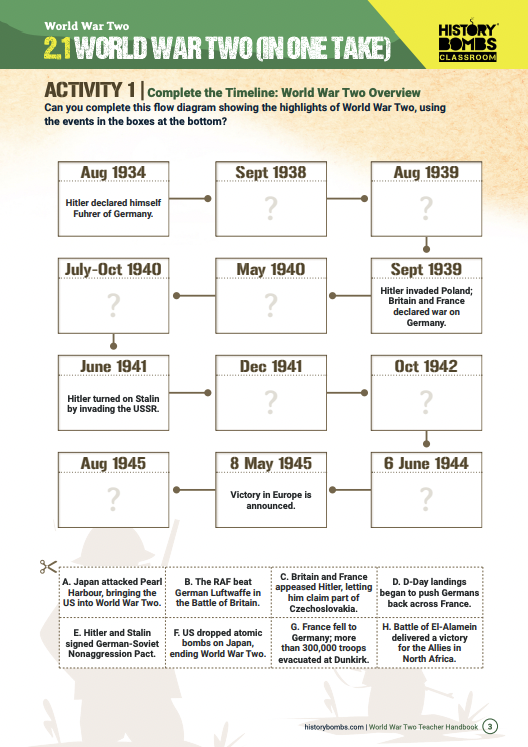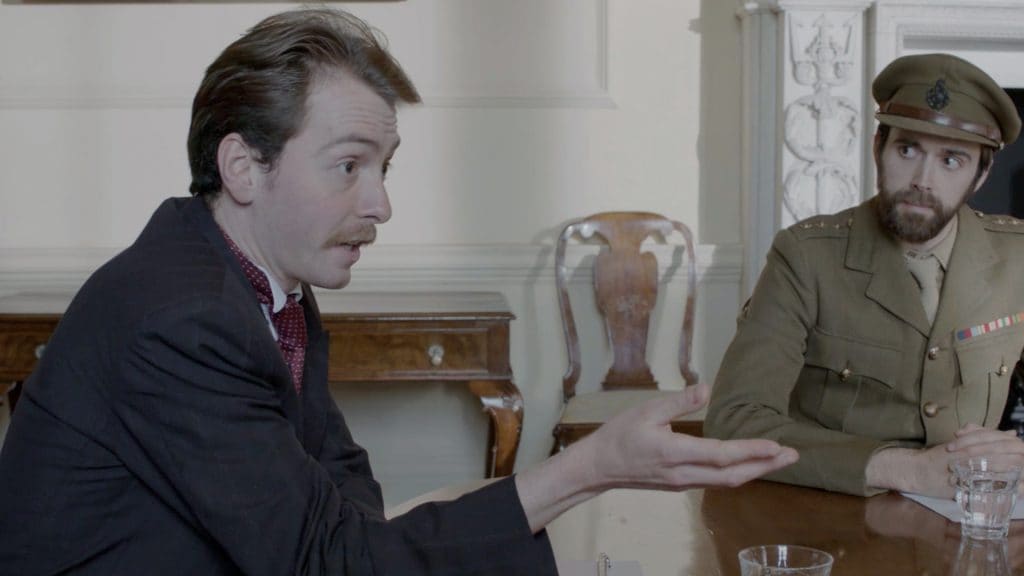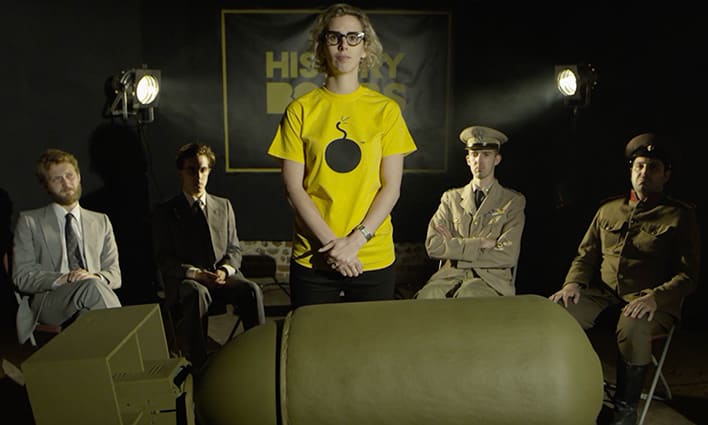Guide your students through some of World War Two’s most important questions with our captivating video lessons and teaching materials.
Here’s an overview of our World War Two series, and advice on creating unforgettable history lessons which will challenge and engage your students.
2.1 History of World War Two (in One Take)
This fast-paced musical video takes you on tour through the Second World War in just seven minutes!
Covering the chronology of the war, from Hitler declaring himself Fuhrer in 1934 to the US dropping atomic bombs on Hiroshima and Nagasaki in 1945, this video introduces students to the main European leaders, alliances, and battles of the Second World War.
Alongside this video, our downloadable teacher pack comes with three captivating classroom activities that can be used with students at both primary and secondary level.
The first classroom activity is a timeline activity, which is designed to help students establish a clear understanding of the chronology of key events.

The second activity is a ‘truth spectrum’, in which students are confronted with a list of statements about World War Two, and students must apply their reasoning skills to choose the correct answers.
The last activity asks students to imagine they are a film producer creating their own History Bombs video, but they must choose which eight events they think are important enough to include, and which eight they would erase.
This will engage students in critical thinking, asking them to evaluate the most significant events of World War Two and explain their reasoning.
2.2 Was British Appeasement right?
This video covers Britain’s actions in the years leading up to the Second World War in a rap-style cabinet debate between Neville Chamberlain, Winston Churchill, General Ironside, and a Colonial Officer.
The video covers the concept of appeasement and the arguments for and against it, as well an analysis of Neville Chamberlain as Prime Minister and whether the war could have been avoided.
The accompanying classroom activities include a tension map, where students plot key events along a timeline, deciding how high they think tensions between the European powers reached.
The second activity asks students to read a list of opinion sentences and decide whether they support or oppose appeasement.
The last activity asks students to write an article either in support of or against Chamberlain’s policy, based on their own conclusions from the previous activity. This allows students to form their own opinions based on what they have seen and develops students’ critical thinking skills.
2.3 What was life like on the Home Front?
In this video, we visit London during the Blitz and speak to the people contributing to the war effort at home. The video also introduces the idea of ‘Blitz spirit’ and questions whether this sense of collective purpose and patriotic duty really applied to all.
The first classroom activity to use with this lesson is a vocabulary based activity, which will consolidate students’ understanding of the key concepts about the Home Front.
The second activity asks students to pull ideas they have heard from the video about arguments for and against Blitz spirit.
The last activity gets students to imagine they are one character from a list of different civilians living through the war and write a diary entry from their perspective, explaining their view of the war.
2.4 Which ally deserves most credit for victory?
This video explores the Allied nations of World War Two – the UK, the USSR and the US, and their contributions to the final defeat of Nazi Germany.
This video is an amusing way to get students to analyse the different contributions that the Allied forces made towards victory, and to consider the victory from the perspective of Nazi Germany. Students will also learn about the most significant battles and turning points of the war.
The first activity asks students to match statements with the Allied nation they are describing, consolidating their knowledge about key events in the lead up to the defeat of Nazi Germany.
The second activity asks students to rank the nations, deciding for themselves which nation deserves most credit for defeating Germany. This allows for critical thinking about the significance of key events at the end of the war.
The last activity asks students to organise statements under argument headings, deciding the most important reason why the Nazis lost the war.
2.5 Atomic Bomb debate
Is it possible to justify the dropping of two atomic bombs on Japan in 1945, which killed an estimated 185,000 people, most of whom were Japanese civilians?
At face value, these horrific acts would appear entirely immoral and indefensible, yet the picture becomes blurred when we consider the global context.
This video asks students to consider the viewpoints of US Secretary of State, James Byrne, Admiral Leahy, the USSR and President Truman.
The first activity consolidates the timeline of events which relate to the US’ involvement in World War Two to place the atomic bombs in context.
The second activity reinforces key vocabulary regarding the atomic bombs, including the Manhattan Project and the Arms Race.
The final activity puts forward a variety of statements with a range of opinions on whether the bombs can be considered a morally justifiable act or not, which a focus on critical thinking and evaluation.
Summary
Whether used as a complete course of study, or slotted into your existing lesson plans, our short-form videos and activities are designed to help you bring World War Two to life for your students.
Get full access to this course as well as seven further captivating topics with one of our affordable memberships.
Additionally, you can purchase a print copy of all teaching materials with a full colour World War Two Teacher Handbook.




